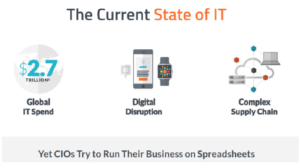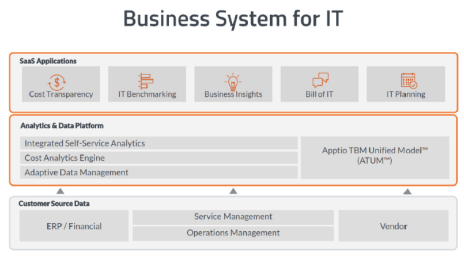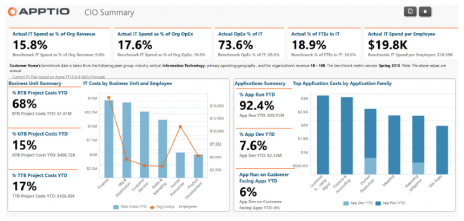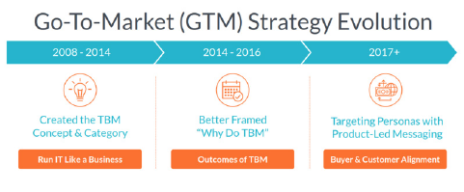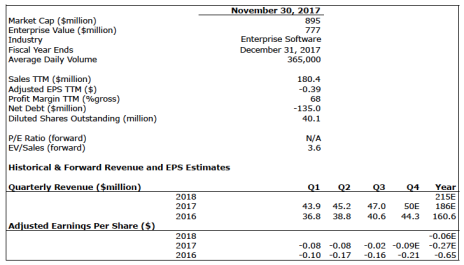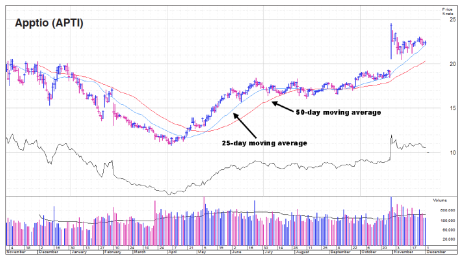There are only a few companies out there that provide the software that companies can use to implement IT cost-accounting. Today’s Cabot Small-Cap Confidential candidate is pioneering the entire movement.
Cabot Small Cap Confidential 223
[premium_html_toc post_id="141911"]
THE BIG IDEA
With most early-stage investments, who you buy is just as important as what you buy. In other words, a company’s leadership team is as important as its technology.
Which brings us to this man, Sunny Gupta.
Mr. Gupta grew up in India where his dad was the Secretary of Education for the Indian government.
His mom’s family was full of entrepreneurs. It was clear to him from around the time he was eight that entrepreneurship was more up his alley than education.
Fast forward about a decade, to 1989. With two grand in his pocket from his dad, Mr. Gupta arrived at the University of South Carolina on a partial scholarship. He washed dishes, mowed lawns, and buried himself in his books. He earned a full scholarship, as well as an internship for the President of the University.
After college came software development, product management and consulting. But these careers seemed confining and too slow-paced. Typical entrepreneur, always thinking there’s more out there!
To see if there was, Mr. Gupta co-founded Vigor Technology, which provided enterprise software tools. Vigor was sold to Rational Software, where Mr. Gupta stayed on in the Business Development department, until Rational was acquired by IBM in 2003. His next step was with a small startup that helped companies eliminate website bottlenecks. Then that company was sold.
Around 2005, he co-founded iConclude, which made software to automatically fix technical problems in data centers. Just two years after opening its doors, iConclude was sold for $60 million to publicly-traded Opsware, which helped firms automate IT operations. Mr. Gupta stayed on, but just four months later, Opsware was sold to Hewlett-Packard for $1.6 billion.
What happens when a serial entrepreneur has a chance to go to a large company like HP? They usually don’t go, especially when they’ve been operating a new start-up in stealth mode!
In November 2007, just four months after Opsware was sold to HP, Mr. Gupta and his two partners raised $7 million from Madrone Venture Group and Greylock partners for the next adventure—software that makes it easier for Chief Information Officers (CIOs) to manage the business of information technology (IT).
This was about a decade ago, when VPs of Sales were falling in love with Salesforce (CRM), which pioneered the market for dedicated customer relationship management (CRM) software. CFOs were already reliant on dedicated Enterprise Resource Planning (ERP) software, and HR heads relied on their specialized Human Resource Management (HRM) platforms.
But even though IT spending was going through the roof with a global tidal wave of digital disruptions, IT leaders were still managing their businesses off spreadsheets.
It didn’t make a lot of sense. Technology was advancing rapidly and becoming increasingly strategic, yet CIOs lacked purpose-built software to help them assess costs and return on investments, let alone do a better job of planning and budgeting for the future.
Mr. Gupta and his partners set out to address this pain point by creating software so CIOs could run legitimate businesses. Their vision was to create a powerful platform, then gradually develop applications to track and share the costs and utilization of all the technologies an enterprise was using. Their platform would give CIOs hard core facts, not just the informed estimates, best-guess analysis and undocumented assumptions that often came out of fragmented spreadsheet analysis.
The idea caught on. In 2009, Silicon Valley venture capital (VC) firm Andreessen Horowitz chipped in $14 million, its first investment ever. More funding followed, including $16.5 million in 2010, $50 million in 2012 and $45 million in 2013.
In 2014, the company expanded from its home base in Bellevue, Washington and opened offices in Sydney and Melbourne, Australia. In 2015, it added an office in Denver, Colorado. Last March, it opened an office in Paris, France.
Then it went public, just last September. Sunny Gupta is the current CEO, and his two partners are still on board. Their company appears to be firing on all cylinders, growing revenue by 15% to 20% a year, and tracking toward profitability in 2019.
Its enterprise software is used by over 360 clients, including 40 of the fortune 100. It is hugely valuable in today’s $6 trillion digital economy. As you might expect, this software doesn’t come cheap—the average annual subscription costs over $400,000!
Read on to get all the details on today’s Cabot Small-Cap Confidential candidate.
THE COMPANY/PRODUCT
“I’ve got a role here as the CFO of IT to demonstrate our contribution to the return on sales for Xerox Corporation. If I can figure out a way to shave a point off IT cost as a percent of revenue, how huge would that be for Xerox?”—Xerox CFO of IT, Peter Phillips
Apptio (APTI) is a $895 million market cap software company that develops Technology Business Management (TBM) solutions to help information technology (IT) leaders do a better job of running their business. The easiest way to describe TBM is as an IT department’s software equivalent to finance’s ERP platform, human resources’ HRM platform and sales’ CRM platform.
With Apptio’s software, customers can make strategic, data-driven decisions for hybrid IT workloads, optimize spending for public cloud services (Amazon AWS, Microsoft AZURE, Salesforce.com, etc.), and shift IT investments toward digital initiatives. They can increase the value of IT, better understand and communicate IT costs, and plan and optimize IT investments.
Just picture a massive, multinational company that spends hundreds of millions of dollars on IT every year. Figuring out how this spending is allocated between departments, how many people are actually using software licenses, and what the necessary budget for future IT investments is could be a daunting task. Especially if all the data is manually tracked through general-purpose business intelligence platforms and fragmented spreadsheets.
Apptio’s platform offers a much better solution. It aggregates customer data from disparate sources (such as HR data from Workday, billing data from Microsoft, service management data from HP, VMware and ServiceNow, and general ledger data from Oracle), cleans it and establishes relationships.
It also maps the data into a standard IT operating model (Apptio TBM Unified Model or ATUM) which becomes the business system of record for its customers’ IT departments. Armed with proprietary modeling capabilities, powerful self-service analytics and planning workflows, Apptio’s customers then can make data-driven operational decisions and share information with others throughout the organization.
With Apptio, IT leaders are finally able to see exactly what the organization is spending on IT, optimize and plan IT investment, benchmark financial and operational performance against peers, shift technology resources to where they’re most needed, and navigate the transition to the cloud.
Its customers are large, global organizations across all industries, including federal and state government agencies. Its average annual subscription contract is for around $400,000. It counts over 40 of the Fortune 100 as customers. Most spend over $100 million on IT every year, though management says the range of customer IT spend ranges from less than $10 million to billions of dollars. Given that Apptio’s subscription fees typically range from 0.1% to 0.5% of a customers’ annual IT spend, that translates to a market opportunity of roughly $6 billion (and growing).
A Crash Course in TBM
Technology Business Management (TBM) hasn’t been around for long. In fact, Apptio helped create the software category. But while TBM might be relatively new, it addresses a large market. Global IT spend in 2016 was around $2.7 trillion dollars.
There are many challenges when you try to create a new category of enterprise software, starting with gaining a critical mass of people and organizations to recognize the category to begin with!
Apptio began by holding biannual TBM Summits where leading CIOs would gather to talk about advancing the discipline of managing the business of IT. Participation grew, and in 2012, Apptio formed the TBM Council as a separate non-profit entity to establish industry-endorsed best practices for TBM, and network with others interested in accelerating adoption of TBM solutions. The TBM Council currently has over 3,200 members and a board of directors comprised of CIOs from BMW, Cisco, Maersk, Nike, Aflac, DuPont, Micron, Exxon Mobil and more.
One of the TBM Council’s major achievements was the creation of the TBM Taxonomy, a standard taxonomy to describe cost sources, technologies, IT resources, apps and services. It’s similar to the accounting standards adopted for publicly traded companies, just designed for IT. This TBM Taxonomy has achieved significant levels of validation, including the U.S. Office of Management and Budget (OMB).
A logical next step after developing the TBM Taxonomy was for Apptio to create a proprietary standardized cost and operational model (and encourage customers to use it!). This framework is called the Apptio TBM Unified Model (ATUM). ATUM builds on the TBM Taxonomy by adding a data sourcing framework so that IT, finance and other business units can speak the same language when it comes to discussing the IT operating structure.
Apptio sees the TBM Council as a key part of its effort to define and spread the word about what exactly TBM is. And it’s a great way to build out its partner network, and pull in potential customers too! The company’s partner network includes leading IT technology and services companies, all of which have a vested interest in working together on IT transformation.
The Platform
Apptio has developed a core software platform as well as a number of cloud-based applications that can be deployed individually, depending on a customer’s needs. It currently has seven applications, each of which has modules that customers can implement. The image below shows the current lineup of TBM apps (with one exception, Cloud Cost Management, which was just introduced), as well as their relative cost (indexed to $1.00 for the main app, Cost Transparency) and penetration rate.
Cost Transparency: This is the main application, accounts for a signifcant portion of subscription revenues, and is the foundation upon which all subsequent apps are added. It helps enterprises get the most bang for each buck of IT spending by centralizing financial data, including cost of apps, projects, labor, public cloud, on-premises infrastructure, etc. It also provides tools that help IT leaders keep taps on spending trends and budget variances, strike the right balance between OpEx and CapEx, and align IT investments with business units’ needs.
IT Benchmarking: This app allows customers to compare their IT spending to that of their peers. It provides side-by-side peer benchmarking comparisons by combining Apptio’s own aggregated data with 3rd party data to give relevant peer comparisons with similar cost structures across 23 industries. By viewing apples-to-apples comparisons, IT departments can set targets, validate spending levels, justify budgets and showcase efficiencies.
Business Insights: The app monitors operational IT data, including capacity, performance and utilization, to help organizations identify unused and underutilized IT resources. For example, organizations can analyze the cost and usage of Microsoft Office 365, Salesforce and ServiceNow licenses, identify servers that are underutilized and analyze vender spend.
Bill of IT: This app allocates IT costs to business units, departments and users within the enterprise, with the aim of helping each maximize the value of their IT consumption.
IT Planning: This app helps organizations be more strategic with their IT investments by centralizing the IT budgeting data in an app that allows for collaboration, transparency and IT-specific forecasting tools. Organizations can better match IT budgets with business demand and analyze the full lifecycle of IT investments.
IT Financial Management (ITFM) Foundation – NEW: This app was just launched on July 26, 2017 and is slightly different from Apptio’s other solutions since it’s purpose-built for a single user, with a lower price point, and a very short implementation time. It’s essentially a mix of the Cost Transparency and IT Planning solutions, and empowers IT leaders to analyze and compare scenarios over multiple years, quickly, accurately and continuously, without wrestling with spreadsheets.
Cloud Cost Management – NEW: Apptio’s newest app was unveiled on November 8, 2017 and is designed to help organizations better manage their public cloud consumption and decide where and how to deploy cloud resources. It helps clear up cloud billing confusion to give customers a full picture of their cloud spending, including labor, network and security. It works with both Amazon Web Services (AWS) and Microsoft Azure.
Growth Strategies – What’s Next?
Expand Customer Base Through Targeted Applications
Apptio’s customers are split into two segments: the Strategic Segment, which have over $20 billion in revenue, and the Enterprise Segment (or Global 10,000), which have revenues under $20 billion. Enterprise customers account for roughly 78% of total customers, versus just 70% in 2014. Because there are far more potential Enterprise customers (roughly 10,000, versus 750 potential Strategic customers), Apptio is introducing applications like IT Financial Management (ITFM) Foundation to attract them.
This new wave of solutions is purpose-built for particular buyers, is easy to deploy quickly, and includes software and services in a single price, right around $100,000. The idea behind this product strategy is that by getting more customers into the front-end funnel, Apptio expands its potential market and will have more customers to sell additional products to. It’s already reporting that several ITFM Foundation deals have closed, and that even relatively small companies (revenue of $30 to $100 million) have been buying. We’ll be talking more about this growth strategy as things unfold.
Grow in the Public Sector
The U.S. Federal Government spends over $90 billion in IT, and it wants to become more efficient. To this end, the Federal IT Acquisition Reform ACT (FITARA) empowered Federal Agency CIOs to manage IT spending. And the Office of Management and Budget (OMB) has mandated that federal agencies report on their technology spending using parts of the TBM Taxonomy.
This is a big deal for obvious reasons. And while TBM doesn’t always equal Apptio, the mandate helps pave the way for Apptio. Agencies are at various stages of implementing TBM, and while the govenerment doesn’t move fast, agencies have been asked to report certain investment data according to the TBM Taxonomy as part of the FY 2019 IT budgeting process. Apptio has enjoyed some success selling into this market, including the State of Washington, but hasn’t even tapped the real potential.
How Companies Succeed with Apptio
Here are just a few examples of how Apptio has helped customers manage their IT businesses better.
In 2016 Xerox (XRX) made the decision to split into an $11 billion company focused on document technology and management, and a $7 billion company, Conduent (CNDT), focused on business services. Fortunately, Xerox had been using Apptio’s TBM solutions since 2013 so it was easy to see which services were consumed by which business units, and in what quantities. That helped provision those IT services up to the split date, avoid the need for additional IT post-split, and support the goal of generating $2.4 billion in cost savings by 2018.
KeyBank is one of the nation’s largest financial services companies, but was struggling to provide its partners’ transparency into IT costs because it was manually pulling all the data together. It couldn’t translate costs to run technology for business unit leaders. Apptio’s Cost Transparency and IT Benchmarking applications helped the company take the mystery out of IT, and have conversations about the real costs of IT at KeyBank on a business unit level.
Cisco is a networking technology giant, and over a decade ago, it realized that the IT challenges it faced were similar to those facing modern supply chains. The pieces of IT needed to fit together so Cisco could manage IT services and account for the cost and performance of each IT “part.” It began with Apptio Cost Transparency, and has adopted three more solutions over the years, helping to drive down its app portfolio by 40% and data center footprint by 35%.
The Business Model
Apptio has a software-as-a-service (SaaS) business model. It generates revenue from selling subscriptions, the pricing of which depends on the annual costs managed by its apps, and the number of apps the customer subscribes to. The company is intently focused on maximizing the lifetime value of each customer by selling additional software modules over time (the best metric for this is the net subscription dollar retention rate). This makes sense given that it sells a niche software solution with a relatively high price to a relatively small number of customers. This is a very different business model than a software company that sells low-priced subscriptions to hundreds of thousands (or more) of customers, like Netflix (NFLX), for instance.
Because each new customer acquisition is so significant, Apptio has significant up-front marketing and sales-related expenses, which are recognized as they are incurred (subscription renewals carry far lower costs). By contrast, subscription revenue is recognized ratably over time. Provided the market continues to embrace its solutions, Apptio’s revenue momentum should fuel significant growth in free cash flow and profitability as the quarters tick by.
The Bottom Line
Apptio grew revenue by 21% in 2015, 24% in 2016, and is likely to grow by 15% to 16% in 2017 and 2018. It isn’t growing as fast as many rapid-growth software peers, but that’s more a reflection of the reality that it sells high-priced software to a smaller number of potential buyers.
Management is relentlessly focused on cash flow and profitability, and Apptio is trending toward positive on both measures. Through the first three quarters of 2017 free cash flow stands at positive $8 million, and management expects to reach its goal of positive free cash flow this year. Earnings per share was -$0.78 in 2016, should come in around -$0.27 in 2017, then be barely negative (around -$0.06 in 2018). That said, given the pace of gross margin improvement (up to 72% in Q3 2017 from 67% last year), EPS growth could be faster than expected. The company ended the quarter with $136 million in cash, so a secondary offering is unlikely, unless Apptio expects to make very significant product expansions or acquisitions.
Apptio’s subscription revenue accounts for around 84% of total revenue (the rest is services) and is driving growth (subscription revenue was up 18% in Q3). Services revenue was up 4% in Q3, and is being impacted by shorter deployments, which is a side effect of Apptio’s strategy to introduce easier-to-deploy solutions. Net dollar retention was 100% in the quarter, meaning the company lost zero revenue from subscription customers over the last 12 months.
RISK
New Product Introductions: Part of Apptio’s growth strategy depends on introducing new products that appeal to very specific IT users within the Global 10,000. Its first two releases appear to have hit the mark, but there’s no guarantee the trend will continue.
Development of TBM Market: Since Apptio is both pioneering a new software category and developing solutions for that category, it’s critical that market acceptance of TBM solutions continues to trend positively. At the same time, as the TBM market grows, it’s likely that new competitors will try to step in, most likely with lower-priced and quick-to-deploy solutions.
Customer Adoption and Retention: Given that Apptio relies on fewer subscribers with considerably higher costs per subscription than its peers, the company’s future growth is even more dependent on continued sales team execution, customer retention and upsell opportunities.
International Expansion: Apptio is growing overseas, and last year 25% of revenue came from outside of the U.S. If it fails to build its worldwide customer base, starting with Australia, Singapore and Europe, its long-term growth potential would be diminished.
COMPETITION
Apptio’s primary competition in the TBM solution space is custom-built software, modified legacy ERP solutions and spreadsheet-based processes. The only major, publicly-traded company that it directly competes with is ServiceNow (NOW), which has a suite of solutions that include some TBM capabilities. There are also smaller companies that have niche solutions that solve a specific TBM need. While Apptio has partnered with many of the vendors in the TBM space and is introducing apps (such as IFTM Foundation) that are currently unique in the market, the competitive landscape is sure to change over time.
THE STOCK
Trading Volume: Apptio has a market cap of $895 million and trades and has traded around 365,000 shares daily over the last three months. That’s roughly $8 million worth of stock trading hands each day. That said, trading volume has gone up by over 25% since Q3 earnings came out in the end of October, and has averaged 470,000 shares daily over the last two weeks. Heavy volume days used to be 500,000 shares or more, but that’s much more common now. We’ll have to monitor trading volume for another month or two to see what the new normal is.
Historical Price: APTI went public in September 2016, selling 6.9 million shares at 16. It shot up to over 23 in its first day, then the post-IPO blues struck, and shares wandered down to a low of 10.77 by April 2017. Buyers stepped in there and APTI was back above 15 by late-May. It then traded sideways in the 16 to 18.5 range through late-October, when it broke out above 20 following the release of Q3 earnings. Over the last month, the stock appears to have settled into a comfortable trading range between 21 and 23.
Valuation and Projected Price Target: Shares of APTI trade with a 2018 EV/Sales multiple of 3.6, based on consensus estimates of $215 million in revenue next year. That implies a second consecutive year of revenue growth in the 15% to 16% range. Software peers with a similar growth rate are trading with a 2018 EV/Sales multiple of 5.6, implying APTI could be undervalued by around 50%. Given that its growth rate is toward the lower end of the peer bracket (15% to 20%), and that it has a market cap of under $1 billion, it’s not surprising that APTI is comparatively undervalued. But over time, this should change. My starting target price of 30 implies shares are roughly 35% undervalued right now.
Buy Range (next two months): Initially, I’d like to see buying in the 20 to 23.5 range. That extends down to the 50-day line (and just a hair below the bottom of the post-earnings gap), and just above where the stock traded earlier this week. A wider buy range could extend down to 18, and up to 24, which gives us a roughly 20% buying band. I’ll be updating guidance based on fundamental developments as we go.
The Next Event: Management will present at the Barclays Technology Conference on December 7, after which an audio webcast will be available. This will be a good event to listen to as we’ll get the first public comments since the new Cloud Cost Management solution was unveiled.
Apptio (APTI) Financials
Apptio (APTI 22.31) |
UPDATES ON CURRENT RECOMMENDATIONS
Due to the nature of the stocks recommended, it is to your advantage not to share these recommendations.
Strong Buy means the stock should be bought immediately and is expected to move sharply higher in the very near future.
Buy means accumulate shares at or around the current price.
Hold means just that; hold what you have. Don’t buy, or sell, shares.
Sell means the original reasons for buying the stock no longer apply, and I recommend exiting the position.
Sell a Half means it’s time to take partial profits. Sell half (or whatever portion feels right to you) to lock in a gain, and hold on to the rest until another ratings change is issued.
Stock-specific news from our portfolio holdings has been almost non-existent given we’ve just wrapped up earnings season and a long, holiday weekend. But make no mistake, there’s a lot going on behind the scenes as companies prepare to close out their fourth quarter, and analysts look toward 2018.
Plus, we have a tax code overhaul being worked on (it might have hit a stumbling block late yesterday, we’ll have to see if it gets voted on today), and mounting evidence that synchronized global growth may have arrived, led by strong economies in the U.S., Europe and China. One can look at Global Manufacturing PMI, which has recently hit another high, or take the easy road and just look at a chart of Vanguard’s Total World Stock ETF (VT), which looks like something investors would want to own!
Narrowing our focus back to the U.S., and to the S&P 600 Small Cap Index specifically, we see small caps have just broken out to another fresh high after the index had a concerning dip to its 50-day line in early-November. Our portfolio has followed along, though the pace of its ascent has been somewhat slower given pullbacks in Datawatch (DWCH) and Everbridge (EVBG) this week. On the positive side, we’re back to break-even with BioTelemetry (BEAT) after the stock rallied 13% this week on two big announcements!
Let’s get to the details.
Updates
AppFolio (APPF) is still regrouping after a post-earnings release selloff. The software company, which specializes in property management and legal solutions, hasn’t released any material updates so we’re not operating with any new information. I’m keeping at buy. BUY.
Asure Software (ASUR) has recovered nicely since reporting earnings. The Human Resource Management software specialist, which also has a Workplace Management software division, appears to be back in style, though I suspect shares will be challenged to break above 15 given there’s resistance in that area from this past summer. I think the easy money has been made here in the short-term, but I’m keeping at buy since a break above 15 should signal significantly higher prices. BUY.
AxoGen (AXGN)continues to look incredibly strong following the stock offerings and its second annual analyst day, which was held on November 20. I gave a thorough update on its product development plans in last week’s Special Bulletin, and nothing has changed since. Continue to stick with the momentum here. BUY.
BioTelemetry (BEAT) has been like a sinking ship lately but was thrown a couple of much needed lifelines this week. We’ve been quite certain that good things were going on behind the scenes (they always are with good companies) but without concrete facts speculation can only hold a stock up for so long. So what’s the news? First, BioTelemetry’s Telcare division (the one that purchased the first FDA-cleared cellular-enabled blood glucose monitor) entered into a strategic collaboration with Onduo, which is a virtual diabetes clinic formed through a joint venture between Verily (owned by Google) and Sanofi. Telcare will supply remote blood glucose systems and the resulting data for patients enrolled in Onduo’s diabetes management program, which means these patients can go about their daily lives instead of hanging out at a clinic.
Onduo’s solution includes diabetes tools and services that can be accessed through a smartphone, devices (wireless cellular meters and sensors) that integrate with the mobile app, Personal Care Leaders assigned to each member, and diabetes supplies (blood strips, lancets, etc.) at no cost since Onduo is covered by qualifying insurance. At this point, we don’t know the terms of this collaboration. But on the surface it appears to be a good endorsement for Telcare’s solution and opens the door to a larger deal should Onduo progress with development of its virtual diabetes clinic.
The second bit of news is that BioTelemetry will provide cardiac monitoring services for the Apple Heart Study, which just launched yesterday. The study uses the Apple Watch and a dedicated Apple Heart Study app to try and discover undiagnosed irregular heart rhythms, such as atrial fibrillation. From the rather brief press release it sounds like BioTelemetry will contribute software and monitoring centers. The Apple Heart Study app will probably send the data to BioTelemetry’s monitoring centers, where the data will be evaluated in similar fashion to data collected by all of BioTelmetry’s FDA-approved remote cardiac monitoring devices.
Investors love it whenever a stock is included with Apple in anything, but that also leads to all sorts of speculation as to how big the partnership could become. In this case, it seems logical to me that the highest potential partnership outcome is that, if Apple’s heart monitoring initiative moves forward and Apple Watch gains FDA approval, then Apple supplies the hardware and BioTelemetry’s Healthcare division supplies software and service center support. This would be good for BioTelemetry since its Healthcare division has the highest gross profit margin (around 68%), whereas its Technology division (which manufactures medical devices) only has a gross profit margin of 31%. I’m guilty of speculating here, but that’s my early analysis. And it, along with the stock’s recent move, means the stock is now a buy. BUY.
Datawatch (DWCH) hasn’t released any new news but shares remain weak and are trading at the same level they were at back in early July (around 9). There should be considerable support here given that the stock bounced off this same level in early August, and we’re right at the 200-day moving average line. I still see significant potential but clearly, the trend is not bullish. Keep in mind this is a microcap and it’s going through an extended process to move to the cloud. If you saw what happened to Autodesk’s (ADSK) stock this week, you know that a stock’s trajectory isn’t linear during this transition! It’s kind of a messy process. But ultimately, is a good move. We’ll give Datawatch a little more rope, but not too much. Moving to hold given the bearish trend. HOLD.
Everbridge (EVBG) has given back all of its post-earnings gain, which isn’t too surprising given that a bunch of the CEOs shares are hitting the market and the company issues around $100 million in convertible debt. As I discussed a couple of weeks ago when I went deep into the details of this capital raise, I think the obvious use of the cash is to accelerate new product development, or get ready for an acquisition (or a couple). I’m keeping the stock at buy, on the premise that the stock will recover following any weakness related to this debt issuance and non-dilutive stock offering from the CEO. BUY.
LogMeIn (LOGM) has a very similar looking chart as Everbridge; a post-earnings rally that was given back in the weeks after reporting. There is no new news to report here either, and we’re just riding our position in this mid-cap to see where it takes us. Keep holding on. HOLD HALF.
Materialise (MTLS) announced two new partnerships recently, which has helped the stock recover back near its 50-day line following a post-earnings release selloff. The first was an OEM license agreement to incorporate metal additive manufacturing (AM) process simulation software into Materialise Magics software. The second is an agreement to bundle Materialise software with HP Multi Jet Fusion printers. There’s been no new news since those announcements, but I think they’ve helped increase investor confidence in the long-term potential of the company’s 3D printing industry offerings, even while the industry adapts to the entry/disruption of HP. I’m keeping at buy. BUY.
Primo Water (PRMW) was moved back to buy after the drinking water company reported a quarter that was good enough to get analysts to boost their price targets. Since then the stock has climbed from around 11 to 13. There’s some resistance in the 13 to 14 range so don’t be surprised if shares pause here before making their next move. I’m keeping at buy since I think they’ll punch through. But as with Asure, I think the easy money has been made in the short-term. Just keep new buys on the small side. BUY.
Q2 Holdings (QTWO) dropped back to its 50-day line this week as most technology stocks sold off. Still, the long-term trend is solid, and the 50-day line been a reliable place to buy. As I said a couple of weeks ago, there was some potential for the stock to dip given management’s commentary about banking/credit union consolidation leading to modest customer count contraction. But it appears investors understand that the long-term benefits of bigger client wins mean more users on the platform. And that pushes revenue, EPS and cash flow higher over time. Keeping at buy. BUY.
Tactile Systems (TCMD) was moved to sell after shares fell following quarterly results. No meaningful updates since. SOLD.
U.S. Concrete (USCR) made a quick move down to its 200-day line last week but came roaring back after the holiday weekend, and just jumped out to a two-month high. The next threshold is the 83 to 84 range, and a break of that zone would clear the sky for a run to all-time highs. Keeping at buy. BUY.
Please email me at tyler@cabotwealth.com with any questions or comments about any of our stocks, or anything else on your mind.
Next Cabot Small-Cap Confidential issue is scheduled for January 5, 2018
Cabot Small-Cap Confidential is published by the Cabot Wealth Network, an independent publisher of investment advice. Neither the corporation nor its employees are compensated in any way by the companies whose stocks we recommend. Sources of information are believed to be reliable, but they are in no way guaranteed to be complete or without error. Recommendations, opinions or suggestions are given with the understanding that subscribers acting on information assume all risks involved. Copyright © 2017 - COPYING AND/OR ELECTRONIC TRANSMISSION OF THIS NEWSLETTER IS A VIOLATION OF THE U.S. COPYRIGHT LAW. For the protection of our subscribers, if copyright laws are violated by any subscriber, the subscription will be terminated.
[premium_html_footer]



